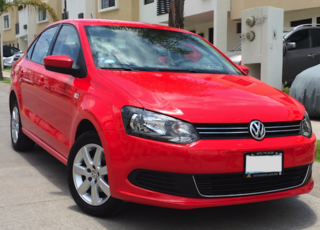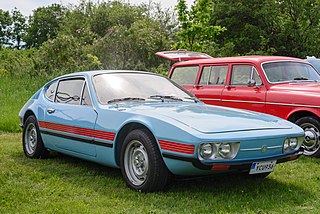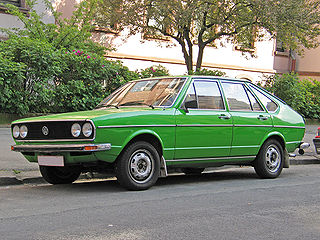
The Fiat Uno is a supermini manufactured and marketed by Fiat. Launched in 1983, the Uno was produced over a single generation in three and five-door hatchback body styles until 1995 in Europe — and until 1 January 2014, in Brazil. Designed by Giorgetto Giugiaro of Italdesign, the Uno strongly recalled the high-roof, up-right packaging of Giugiaro's 1978 Lancia Megagamma concept, in a smaller configuration.

The Fiat Tipo is a compact car, designed by the I.DE.A Institute design house, and produced by the Italian manufacturer Fiat between 1988 and 1995.

The Volkswagen Passat is a series of large family cars manufactured and marketed by the German automobile manufacturer Volkswagen since 1973, and now in its eighth generation. It has been marketed variously as the Dasher, Santana, Quantum, Magotan, Corsar and Carat. The successive generations of the Passat carry the Volkswagen internal designations B1, B2, etc.

The Ford Versailles was a mid-size automobile between 1991 and 1996 in Brazil and Argentina. It was a version of the Volkswagen Santana sold in the 1990s, when Ford and Volkswagen shared models in South America in a joint venture known as Autolatina. It replaced the Ford Del Rey in Brazil and the locally built Ford Sierra in Argentina. The station wagon version was sold as the Ford Royale.

The Volkswagen Santana is a nameplate used by Volkswagen for various sedans and station wagons since 1983. The first generation is based on the second-generation Volkswagen Passat (B2). It was introduced in 1981 while production started in 1983 for China and 1984 for Europe. The use of the "Santana" badge rather than "Passat" echoes the use of different names for the sedan versions of the Polo (Derby) and Golf (Jetta).

The Volkswagen Gol is a subcompact car that has been manufactured by Volkswagen do Brasil since 1980 as Volkswagen's entry-level car in the Latin American market—where it succeeded the Volkswagen Type 1 (Fusca) and the Volkswagen Brasilia. Several variants of the Gol-derived Voyage and Parati were marketed in North America as the Volkswagen Fox from 1987 to 1993.

The Fiat Oggi is a two-door sedan based on the Fiat 147, a subcompact car produced in South America by Italian automaker Fiat. The Oggi was produced in Brazil from 1983 until 1985, when it was replaced by the Uno-based Prêmio. This car was a response to the new sedans in the Brazilian market, the Chevrolet Monza, the Volkswagen Voyage and later the Ford Escort.

The Fiat 147 was a three-door hatchback subcompact car produced by Fiat in the Brazilian state of Minas Gerais from autumn 1976 until 1987, when it was replaced by the Fiat Uno. It was the Brazilian variant of the Fiat 127. Some were also built by Sevel in Argentina until 1996, and assembly also took place in Colombia, Uruguay, and Venezuela.

International Indústria Automotiva da América do Sul Ltda. is a Brazilian company specialised in the manufacturing of diesel engines for automotive applications. Until 2005, it was known as MWM Motores Diesel Ltda.

The Fiat Fiorino is a small commercial vehicle produced by the Italian car manufacturer Fiat since 1977. Its first two generations have been the panel van derivatives of other small models, such as the Fiat 127 and Fiat Uno, while the current third generation was developed jointly with PSA Peugeot Citroën, and is based on the Fiat Small platform.

The Volkswagen Brasília is a rear-engined compact car, manufactured and marketed by Volkswagen in Brazil between 1974 and 1982; in Mexico from 1975 to 1982; and as knock down kits in Nigeria where it was marketed as the Igala from 1976 to 1980.

The Volkswagen Vento is a subcompact car produced by the Volkswagen India and Volkswagen Russia subsidiaries of the German manufacturer Volkswagen since 2010. It is essentially a three-box Volkswagen Polo with a stretched wheelbase and has been developed especially for some markets. The car is sold under the Vento nameplate in India, Malaysia, Brunei and Mexico. In Thailand, South Africa, Argentina, Russia, Jordan, Morocco, Algeria, Tunisia and the Middle East, it is sold as the Volkswagen Polo Sedan. The name Vento means 'wind' in both Italian and Portuguese. It is also known as the Volkswagen Polo Notch in the Philippines.

The SP2 is a sports car developed by Volkswagen do Brasil for the Brazilian market, and produced from 1972 until 1976. It is based on the Brazilian market Volkswagen 1600 Variant. The abbreviation "SP" is said to have stood for São Paulo or, according to other sources, for Special Project, Sport Prototype, Special Performance or SPort-Car.

The Volkswagen Golf Mk2 is a hatchback, the second generation of the Volkswagen Golf and the successor to the Volkswagen Golf Mk1. It was Volkswagen's highest volume seller from 1983 and ended in (German) production in late 1992, to be replaced by the Volkswagen Golf Mk3. The Mk2 was larger than the Mk1; its wheelbase grew slightly, as did exterior dimensions. Weight was up accordingly by about 120 kg (260 lb). Exterior design, developed in-house by VW design director Schäfer, kept the general lines of its Giugiaro-designed predecessor, but was slightly more rounded. All told, about 6.3 million second-generation Golfs were built.

The Brazilian automotive industry is coordinated by the Associação Nacional dos Fabricantes de Veículos Automotores (Anfavea), created in 1956, which includes automakers with factories in Brazil. Anfavea is part of the Organisation Internationale des Constructeurs d'Automobiles (OICA), based in Paris. In 2021, the annual production exceeded 2.2 million vehicles, the 8th largest in the world.

The Volkswagen Passat (B1) is a large family car produced by Volkswagen in West Germany from 1973 to 1981.

The Volkswagen Passat (B2) is an automobile which was produced by German manufacturer Volkswagen from 1981 to 1988. It was the second generation of the Volkswagen Passat. The platform was slightly longer than the preceding Passat (B1). As with the previous generation, it was based on the platform of the Audi 80; the corresponding B2 version of which had been already launched in 1978. The Santana was also manufactured in China, Brazil, Mexico and Argentina. In Brazil, the Santana station wagon was sold as the Quantum. In the United States, both the Santana sedan and station wagon were sold as the Quantum. The Passat saloon and estate were produced in South Africa for their local market until 1987. The production of Passat B2 in China ended in January 2013.

Designed by Aurelio Lampredi, the Fiat 124 engine first appeared in the all-new Fiat 124 in April 1966. The in-line four-cylinder engine comprised an iron block with an aluminium cylinder-head with pushrod actuated valves. The belt-driven design was ahead of its time when introduced. European production of the petrol versions ended with the Fiat 131 in 1984, but later diesel derivatives continued to be built until 1999. It did have a longer life in its twin-cam iteration, which continued in production until 2000. While originally of an overhead valve design, an overhead cam version was added to the facelifted 131 in 1981. The capacity was initially 1.2 L (1,197 cc), but eventually ranged between 1.2 and 1.9 L. There were also three SOHC diesel iterations of 1.4, 1.7, and 1.9 litres. The last versions of this engine to be built were the diesels. The 1.9 L (1,929 cc) direct-injected diesel version was the first direct-injection diesel to appear in a production passenger car, the Fiat Croma Turbo D i.d.

The Volkswagen Taigo is a subcompact crossover SUV (B-segment) with a sloping roofline manufactured by the German automaker Volkswagen. Based on the Mk6 Polo, the Taigo is built on the Volkswagen Group MQB A0 platform.
Designed by Aurelio Lampredi, the Fiasa engine first appeared in the Brazilian-built Fiat 147 in September 1976. The name Fiasa is a portmanteau of "Fiat Automóveis S.A.", for whom it was developed. The in-line four-cylinder engine has five main bearings, a cast iron block with an aluminium cylinder-head with belt-driven overhead camshafts actuating the valves. The engine remained in production until 2001 in Latin America, and also provided the basis for a diesel version. The capacity was initially 1.0 L (1,049 cc), but Lampredi designed the engine to be suited for a considerably longer stroke. Sizes eventually ranged between 1.0 and 1.5 L. The last versions of this engine to be built was a 1.5-litre, dedicated-ethanol version developed in Brazil that served the Fiat Uno and its derivatives, and later yet the Fiat Palio until 2001.



















